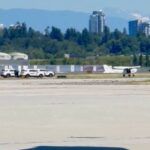In a dramatic sequence of events that stunned the Pacific Northwest aviation community, authorities have arrested a suspect following the hijacking of a small aircraft that originated from Victoria International Airport and circled Vancouver International Airport for several tense hours on Thursday.
The incident began shortly after 2:30 PM when the suspect, whose identity has not yet been released pending formal charges, allegedly commandeered a single-engine Cessna from Victoria. Air traffic controllers quickly noted the aircraft’s unauthorized departure and erratic flight pattern, prompting immediate security protocols at both airports.
“This type of aviation security breach is extremely rare in Canadian airspace,” said RCMP Superintendent James Harwood. “Our coordinated response with Transport Canada and airport authorities functioned exactly as designed to contain the situation without casualties.”
Flight tracking data showed the aircraft made several unpredictable turns while maintaining a circular pattern around Vancouver International Airport, causing significant disruption to commercial flight operations. At least seventeen scheduled arrivals and departures faced delays or diversions during the three-hour ordeal.
Transport Canada immediately established a temporary no-fly zone extending five nautical miles around the hijacked aircraft, while Vancouver Airport operations shifted to emergency procedures. Passengers inside the terminal described a scene of controlled urgency as security personnel implemented containment protocols.
“We were waiting to board when announcements came over the PA system about operational delays,” said Melissa Chang, a passenger whose flight to Calgary was postponed. “The staff remained calm, but you could sense something serious was happening.”
The crisis reached its conclusion when the aircraft, running low on fuel, was guided to land at a secured section of Vancouver International Airport. Tactical units from the RCMP Emergency Response Team surrounded the plane within moments of touchdown, successfully apprehending the suspect without injuries.
Aviation security expert Dr. Allan Merrick of the University of British Columbia noted the incident highlights both strengths and vulnerabilities in Canada’s aviation security framework. “While commercial aviation has robust security measures, smaller aircraft operations have inherently different risk profiles that present unique challenges,” he explained.
Transport Minister Pablo Rodriguez issued a statement confirming a full investigation is underway, with potential changes to general aviation security protocols being considered. “The safety of our airways is paramount, and today’s events, while resolved without tragedy, merit careful examination of our security procedures,” the statement read.
The suspect faces multiple serious charges, including aircraft piracy, endangering aviation safety, and transportation of dangerous goods. Authorities indicate additional charges may follow as the investigation unfolds.
As Canada’s aviation community processes this rare security breach, questions emerge about the balance between accessibility and security in general aviation. How might this incident reshape the relationship between the freedom that defines recreational flying and the security imperatives of a post-9/11 world?










